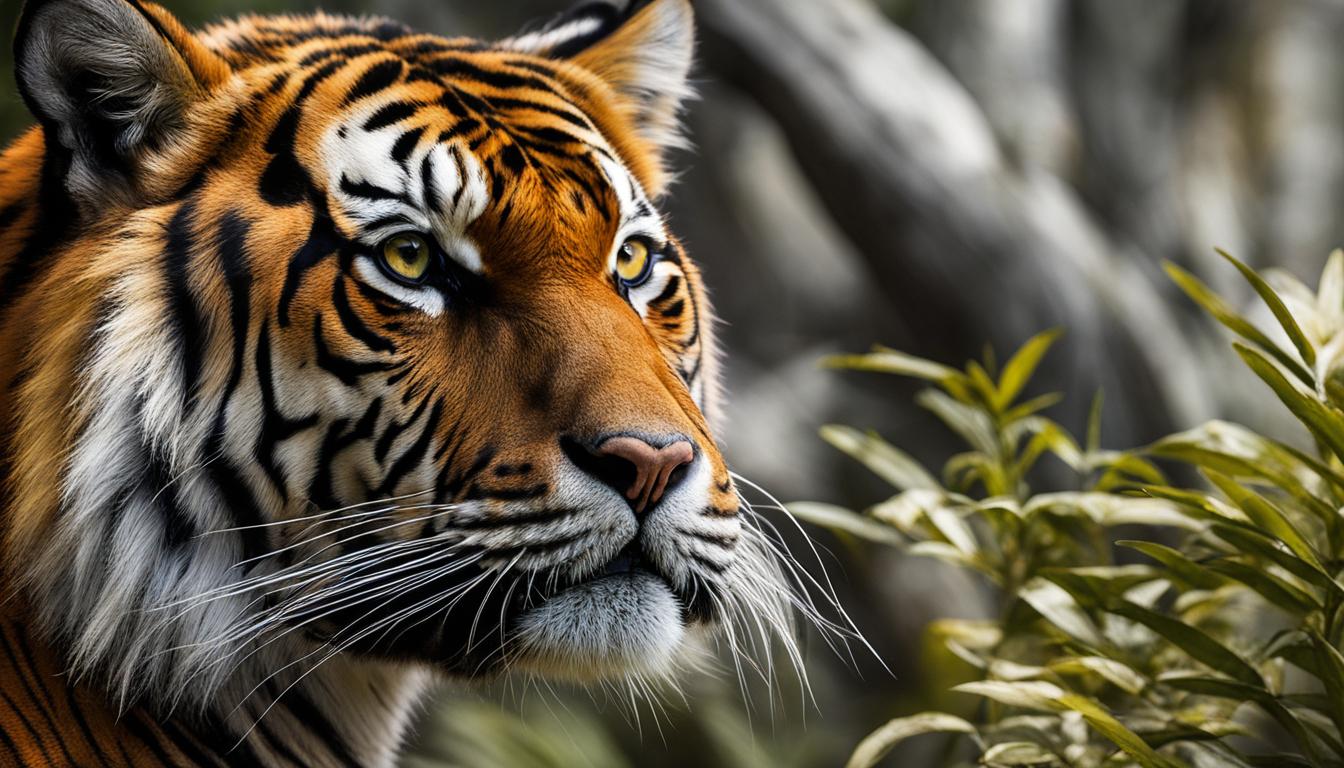Tigers are fascinating creatures with a combination of beauty, strength, and unique characteristics. If you’re curious to learn more about these majestic animals, we’ve got you covered with some interesting tiger facts!
Key Takeaways:
- Tigers are the largest wild cats, with males weighing up to 300 kilograms.
- One swipe from a tiger’s front paw can be deadly.
- Tigers prefer to hunt at night and are excellent swimmers.
- Tiger cubs are born blind and have a high mortality rate.
- They can mate with other big cats, creating hybrid animals like tigons and ligers.
Tigers and their Unique Physical Characteristics
Tigers are truly magnificent creatures, known for their impressive size and strength. They are the largest wild cats, with males weighing up to a staggering 300 kilograms. These majestic animals can measure up to 2.8 meters in length, making them truly formidable in appearance.
One of the most distinctive features of tigers is their striking striped coat. Each tiger has over 100 stripes, and no two tigers have the same pattern. These stripes are like a fingerprint, unique to each individual. The beautiful coat of a tiger serves as camouflage, helping them blend into their surroundings while hunting.
Tigers possess incredible physical attributes that contribute to their prowess as hunters. With powerful jaws and teeth, they are capable of delivering a bite that can instantly kill their prey. Tigers also have exceptional night vision and hearing, allowing them to navigate their surroundings and detect the slightest movement. These impressive senses make them highly efficient and successful hunters in the darkness of night.
| Tiger Attribute | Description |
|---|---|
| Size and Weight | Males can weigh up to 300 kilograms and measure up to 2.8 meters in length. |
| Stripes | Tigers have over 100 unique stripes, acting as camouflage while hunting. |
| Senses | Excellent night vision and hearing enable tigers to be efficient nocturnal hunters. |
| Jaws and Teeth | Powerful enough to deliver a fatal bite that can instantly kill their prey. |
“Tigers are the epitome of strength and beauty, with their distinctive stripes and powerful physique. Their unique physical characteristics make them truly awe-inspiring creatures.”
Tigers’ hunting habits and behavior
Tigers are known for their unique hunting habits and distinctive behavior. As solitary hunters, they prefer to search for food alone, typically during the night when their excellent night vision provides them with an advantage over their prey. They rely on their stealth and patience to stalk their victims silently, gradually closing in until they are within striking distance.
Once a tiger has closed in on its prey, it delivers a fatal bite to the neck or back of the head, ensuring a quick and efficient kill. This method allows tigers to take down large mammals, such as deer, wild pigs, and buffalo. In a single feeding, a tiger can consume up to 30 kilograms of meat, demonstrating their impressive hunting prowess and their ability to sustain themselves.
Tigers are not only skilled land hunters; they also exhibit a unique affinity for water. Unlike most cats, tigers are excellent swimmers and are known to swim and hunt in water. Their love for water and their ability to swim for several kilometers further illustrates their adaptability and agility as hunters. By utilizing their strength and stealth, tigers are able to secure their meals and maintain their status as apex predators in their ecosystems.
“Tigers are true masters of the hunt, employing their keen senses and formidable physical attributes to secure their prey. Their solitary nature and ability to adapt to various environments make them incredible predators in both land and water.”
The conservation status of tigers
Tigers are currently facing a critical conservation status, with their population declining significantly over the past century. Various factors have contributed to their endangered status, including poaching for their pelts and body parts, habitat loss, and human-wildlife conflict. It is important to recognize the importance of tiger conservation and take action to preserve these magnificent animals.
According to the International Union for Conservation of Nature (IUCN), tigers are classified as critically endangered. Their population has been reduced to less than 3,900 individuals worldwide. Poaching remains a major threat, driven by the demand for tiger parts in traditional medicine and the illegal wildlife trade. Tigers are killed for their skins, bones, and other body parts, which are believed to have various medicinal properties.
Habitat loss is another significant factor endangering tigers. Deforestation, primarily for agriculture and logging, has resulted in the destruction and fragmentation of their natural habitats. The loss of suitable forest areas reduces the availability of prey and disrupts the tigers’ territorial range. As human activities continue to encroach upon tiger habitats, the conflicts between tigers and local communities escalate, leading to retaliatory killings and further habitat degradation.
| Tiger Conservation | Endangered Tigers | Tiger Population |
|---|---|---|
| Stricter anti-poaching laws | Efforts to protect and recover tiger populations | Less than 3,900 individuals worldwide |
| Habitat restoration | Preservation of natural habitats | Significant decline over the past century |
| Community-based conservation initiatives | Engaging local communities in tiger conservation | Poaching, habitat loss, and human-wildlife conflict |
Efforts are being made to safeguard tiger populations and their habitats. Conservation organizations, governments, and local communities are working together to implement stricter anti-poaching laws, restore and protect natural habitats, and engage in community-based conservation initiatives. These efforts have shown some positive results, with certain tiger populations starting to recover in protected areas.
To ensure the long-term survival of tigers, it is crucial for individuals to support these conservation efforts. Increasing public awareness about the plight of tigers, their ecological importance, and the need for sustainable practices is essential. By taking action and supporting organizations dedicated to tiger conservation, we can help protect these magnificent creatures and preserve the biodiversity of our planet for future generations.
The different species and subspecies of tigers
Tigers are a diverse group of big cats, with various species and subspecies inhabiting different parts of the world. Each type of tiger has its own unique characteristics and adaptations that help it thrive in its specific environment.
One of the most well-known and iconic species of tiger is the Bengal tiger. Found in the Indian subcontinent, the Bengal tiger is known for its beautiful orange coat with black stripes. It is the most numerous and widespread subspecies, with a population that is primarily concentrated in India and Bangladesh.
The Siberian tiger, also known as the Amur tiger, is the largest subspecies of tiger. It is adapted to the harsh climate of the Russian Far East and northeast China. Siberian tigers have a thick fur coat and a stocky build, which helps them survive in the cold winters of their habitat.
The Sumatran tiger, found on the Indonesian island of Sumatra, is the smallest subspecies of tiger. It has a darker coat compared to other tigers, with narrower stripes. Due to habitat loss and poaching, the Sumatran tiger is critically endangered and faces an uncertain future.
| Tiger Species/Subspecies | Physical Characteristics | Native Range |
|---|---|---|
| Bengal Tiger | Orange coat with black stripes | Indian subcontinent (India, Bangladesh) |
| Siberian Tiger (Amur Tiger) | Largest subspecies, thick fur coat | Russian Far East, northeast China |
| Sumatran Tiger | Darker coat, narrower stripes | Sumatra (Indonesia) |
These are just a few examples of the different species and subspecies of tigers that exist. Each one is a remarkable animal in its own right, showcasing the incredible diversity and adaptability of these magnificent creatures.
The importance of tigers in ecosystems
Tigers play a crucial role in maintaining the balance of ecosystems. As top predators, they help regulate the populations of herbivores, which prevents overgrazing and maintains the health of plants and vegetation. By controlling the number of herbivores, tigers indirectly influence the distribution of plant species and shape the structure of forests. They also prevent certain herbivores from becoming dominant and causing damage to the ecosystem.
Furthermore, tigers contribute to nutrient cycling in their habitats. When tigers hunt and kill their prey, they consume a portion of the animal but leave behind carcasses and leftovers. These remains provide food for scavengers and decomposers, which play a vital role in breaking down organic matter and recycling nutrients back into the ecosystem.
In addition to their ecological impact, tigers also help maintain biodiversity. As apex predators, they promote species diversity by controlling the populations of smaller predators and preventing them from negatively affecting other species. By preserving the delicate balance of predator-prey relationships, tigers play a vital role in ensuring the health and resilience of ecosystems.
The role of tigers as top predators
Tigers are considered top predators because they have no natural predators themselves. Their position at the top of the food chain gives them significant influence and control over the ecosystem. Without tigers, the balance of the food web could be disrupted, leading to cascading effects throughout the entire ecosystem.
“Tigers are essential for maintaining the delicate equilibrium of ecosystems. Their presence ensures the health and vitality of forests, rivers, and other habitats.”
Their ability to regulate herbivore populations helps prevent overbrowsing, which can lead to habitat degradation and the loss of valuable plant species. By keeping the herbivore population in check, tigers indirectly support the diversity of vegetation and promote a healthy and thriving ecosystem.
| Tiger’s Role in Ecosystems | Impact |
|---|---|
| Regulating herbivore populations | Prevents overgrazing and maintains plant and vegetation health |
| Contributing to nutrient cycling | By providing food for scavengers and decomposers |
| Maintaining biodiversity | By controlling the populations of smaller predators |
Protecting tigers is not just about conserving a single species; it is about preserving entire ecosystems and the biodiversity they support. By recognizing the vital role that tigers play in maintaining ecosystem balance, we can work towards their conservation and ensure a sustainable future for both tigers and the environments they inhabit.
Threats to Tiger Populations and Conservation Efforts
Tigers face numerous threats that pose a significant risk to their survival and conservation efforts. These threats include illegal poaching, habitat loss, and human-wildlife conflict. Poaching is one of the major issues faced by tigers, driven by the demand for their valuable body parts in illegal wildlife trade. This relentless hunting puts immense pressure on tiger populations and exacerbates their endangered status.
Habitat loss is another critical threat to tigers. Deforestation and human encroachment result in the destruction and fragmentation of their natural habitats, leaving tigers with limited space to roam and find prey. As their habitats diminish, tigers are forced into smaller areas, increasing the likelihood of conflicts with humans.
Human-wildlife conflict arises when tigers come into contact with local communities living near their habitats. This conflict can occur when tigers prey on livestock or when humans unintentionally encroach on tiger territories. The resulting conflicts often lead to retaliation killings or the capture of tigers, further endangering their populations.
The Role of Conservation Organizations
Despite these challenges, numerous conservation organizations are actively working to protect tigers and mitigate the threats they face. These organizations play a crucial role in raising awareness, implementing conservation strategies, and collaborating with governments, local communities, and other stakeholders.
“Conservation organizations are at the forefront of efforts to protect tigers and safeguard their habitats. Their tireless work is instrumental in ensuring the survival of these magnificent creatures.”
Conservation organizations focus on various aspects of tiger conservation, such as anti-poaching initiatives, habitat restoration, community-based conservation, and education and awareness programs. They work towards strengthening legislation and enforcement against poaching, while also promoting sustainable livelihoods for communities living near tiger habitats.
By supporting these organizations through donations, volunteer work, and raising awareness, individuals can contribute to the conservation of tigers and help secure their future. Together, we can make a difference and ensure that these majestic animals continue to roam our planet for generations to come.
Conclusion
Tigers are truly remarkable creatures, possessing a combination of physical prowess and captivating behaviors. However, these majestic animals face significant threats due to human activities. It is imperative that we take action to protect tigers and their habitats in order to secure their future survival.
By raising awareness about tiger conservation and supporting initiatives aimed at preserving their habitats, we can make a meaningful impact. Tigers are not just iconic symbols of power and grace; they also play a crucial role in maintaining the balance of ecosystems and safeguarding biodiversity.
It is our responsibility to ensure that future generations have the opportunity to witness the beauty and wonder of these incredible creatures. Through our collective efforts, we can make a difference in saving tigers from extinction. Join the movement to protect these magnificent animals and contribute to the preservation of our natural world.
FAQ
What are some interesting facts about tigers?
Tigers are the largest wild cats, weighing up to 300 kilograms. They have over 100 stripes, and each tiger’s pattern of stripes is unique, like a human fingerprint. Tigers have fake eyes called “ocelli” on the back of their ears, which scare other animals. They can run at speeds of up to 65 kilometers per hour.
What are some unique physical characteristics of tigers?
Tigers are the largest wild cats, weighing up to 300 kilograms and measuring up to 2.8 meters in length. They have powerful jaws and teeth, capable of delivering a bite that can kill prey instantly. Tigers have excellent night vision and hearing, allowing them to be successful hunters. They have fake eyes called “ocelli” on the back of their ears, which scare other animals.
What are the hunting habits and behavior of tigers?
Tigers are solitary hunters, often searching for food alone at night. They stalk their prey silently until they are close enough to pounce, usually delivering a fatal bite to the neck or back of the head. Tigers are carnivores, feeding on large mammals such as deer, wild pigs, and buffalo. They can eat up to 30 kilograms of meat in one feeding. Tigers are also known to swim and hunt in water. They are fast and agile, using their strength and stealth to secure their meals.
What is the conservation status of tigers?
Tigers are considered critically endangered, with the population declining significantly in the last 100 years. Factors such as poaching for their pelts and body parts, habitat loss, and human-wildlife conflict have contributed to their endangered status. India is home to around 70% of the world’s tiger population. Conservation efforts and stricter laws against poaching have helped in the recovery of tiger populations in some areas. However, there is still a long way to go to ensure the survival of these magnificent animals.
What are the different species and subspecies of tigers?
There are five subspecies of tigers: Bengal tiger, Siberian tiger (also known as Amur tiger), Sumatran tiger, South China tiger, and Indochinese tiger. Each subspecies has its own unique characteristics and is adapted to its specific habitat. The Bengal tiger is the most common and widespread, while the Siberian tiger is the largest. Sadly, three subspecies of tigers, the Caspian, Bali, and Javan, are already extinct.
What is the importance of tigers in ecosystems?
Tigers play a crucial role in maintaining the balance of ecosystems. As top predators, they help regulate the populations of herbivores, which prevents overgrazing and maintains the health of plants and vegetation. Protecting tigers is not just about saving a single species; it is about preserving entire ecosystems and the biodiversity they support. By conserving tigers, we contribute to the overall health and sustainability of our planet.
What are the threats to tiger populations and conservation efforts?
Tigers face numerous threats to their survival, including illegal poaching for their valuable body parts, habitat loss due to deforestation and human encroachment, and human-wildlife conflict. Many organizations and governments are working towards tiger conservation, implementing measures such as stricter anti-poaching laws, habitat restoration, and community-based conservation initiatives. It is important for individuals to support these efforts through awareness, education, and responsible tourism.
How can we save tigers and preserve their biodiversity?
Tigers are magnificent creatures, with fascinating physical and behavioral characteristics. However, they are also under great threat due to human activities. It is crucial to raise awareness and take action to protect tigers and their habitats. By supporting conservation efforts and advocating for responsible practices, we can ensure that future generations will continue to admire and appreciate these awe-inspiring animals. Let us come together to save the tigers and preserve the biodiversity of our planet.











